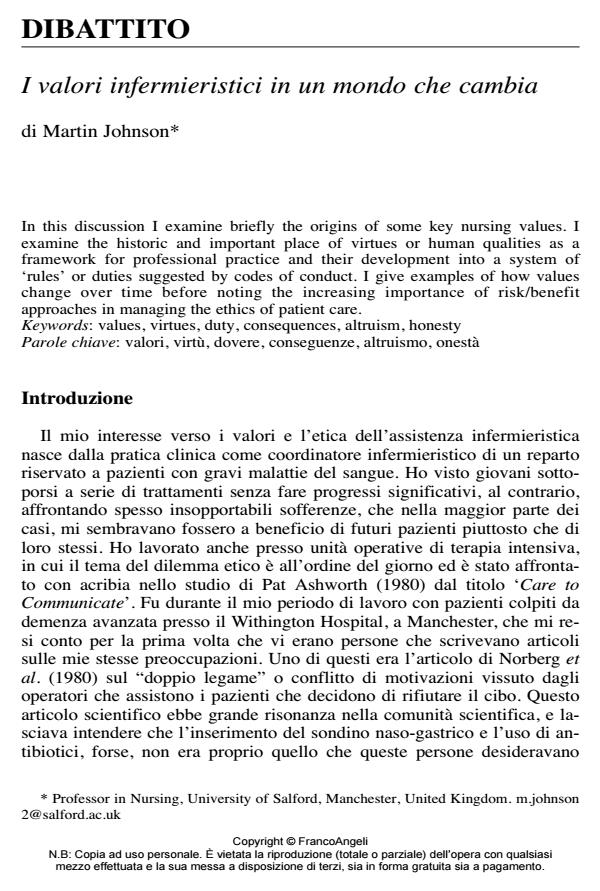I valori infermieristici in un mondo che cambia
Titolo Rivista SALUTE E SOCIETÀ
Autori/Curatori Martin Johnson
Anno di pubblicazione 2013 Fascicolo 2013/3 Lingua Italiano
Numero pagine 16 P. 171-186 Dimensione file 133 KB
DOI 10.3280/SES2013-003013
Il DOI è il codice a barre della proprietà intellettuale: per saperne di più
clicca qui
Qui sotto puoi vedere in anteprima la prima pagina di questo articolo.
Se questo articolo ti interessa, lo puoi acquistare (e scaricare in formato pdf) seguendo le facili indicazioni per acquistare il download credit. Acquista Download Credits per scaricare questo Articolo in formato PDF

FrancoAngeli è membro della Publishers International Linking Association, Inc (PILA)associazione indipendente e non profit per facilitare (attraverso i servizi tecnologici implementati da CrossRef.org) l’accesso degli studiosi ai contenuti digitali nelle pubblicazioni professionali e scientifiche
In this discussion I examine briefly the origins of some key nursing values. I examine the historic and important place of virtues or human qualities as a framework for professional practice and their development into a system of ‘rules’ or duties suggested by codes of conduct. I give examples of how values change over time before noting the increasing importance of risk/benefit approaches in managing the ethics of patient care.;
Keywords:Valori, virtù, dovere, conseguenze, altruismo, onestà
- American Nurses’ Association (2012). The Nightingale Pledge. Retrieved from: http://nursingworld.org/FunctionalMenuCategories/AboutANA/WhereWeComeFrom/FlorenceNightingalePledge.aspx (Accessed 19th November 2012).
- Aristotle (1977) (4th Century BC). Nicomachean ethics. In: Cahn S., ed., Classics of western philosophy. Indianapolis: Hackett Publishing Company.
- Ashworth P. (1980). Care to communicate. London: Royal College of Nursing.
- Bandura A., McDonald F.H. (1963). The influence of social reinforcement and the behaviour of models in shaping children’s moral judgements. Journal of Abnormal and Social Psychology, 67: 274-281.
- Beauchamp T., Childress J. (2001). Principles of biomedical ethics. Oxford:
- Oxford University Press.
- Becker H., Geer B., Hughes E.C., Strauss A. (1961). Boys in white: student culture in medical school. Chicago: University of Chicago Press.
- Costello J. (2004). Nursing the dying patient. Basingstoke: Palgrave MacMillan.
- Crisp R., Slote M., eds. (1997). Virtue ethics. Oxford: Oxford University Press.
- Darwin C. (1929). The origin of species by means of natural selection. London: Watts & Co (First published 1859).
- Department of Health (2008). End of life care strategy: promoting high quality care for all adults at the end of life. The Stationery Office. Department of Health: London.
- Fowler M. (1997). Nursing’s ethics. In: Davis A., Aroskar M., Liaschenko J., Drought T., eds., Ethical dilemmas in nursing practice. Stamford, Connecticut: Appleton & Lange: 17-34.
- Freud A. (1946). The ego and the mechanism of defence. New York: International Universities Press.
- Freud S. (1933). New introductory lectures on psychoanalysis. New York: W.W.Norton.
- Glaser B.G., Strauss A.L. (1965). Awareness of dying. Chicago: Aldine.
- Hockley J. (2006). Developing high quality end of life care in nursing homes: an action research study. In: Department of Nursing, Unpublished PhD Thesis, Edinburgh: Edinburgh University.
- Hoskins S. (2005). Nurses and national socialism - A moral dilemma: one historical example of a route to euthanasia. Nursing Ethics, 12, 1: 79-91, DOI: 10.1191/0969733005ne759oa
- IPASVI (2011). The New Code of Conduct for Italian Nurses. www.ipasvi.it/static/english/the-new-code-of-conduct-for-italian-nurses.htm (Last access: 26th September 2011).
- Johnson M. (2004a). Editorial: Safeguarding children and the future of the Nursing and Midwifery Council. Nurse Education Today, 24, 4: 245-247, DOI: 10.1016/j.nedt.2004.03.006
- Johnson M. (2004b). Real world ethics and nursing research. NT Research, now Journal of Research in Nursing, 9, 4: 251-261, DOI: 10.1177/136140960400900403JohnsonM.,HaighC.Yates-BoltonN.(2007).Valuingofaltruismandhonestyinnursingstudents:atwo-decadereplicationstudy.JournalofAdvancedNursing,57,4:366-374,doi:10.1111/j.1365-2648.2007.04119.x
- Lawton J. (2000). The dying process: Patients’ experiences of palliative care. London: Routledge.
- Long T. (1992). To protect the public and ensure justice is done: an examination of the Phillip Donnelly case. Journal of Advanced Nursing, 17, 1: 15-19, DOI: 10.1111/j.1365-2648.1992.tb01811.x
- Kramer M. (1974). Reality shock: why nurses leave nursing. St Louis: Mosby.
- Maggs C. (1980). Nurse recruitment to four provincial hospitals 1881-1921. In: Davies C., eds., Rewriting nursing history. London: Croom Helm: 18-40.
- Maslow A.H. (1970). Motivation and personality (2nd ed.). New York: Harper and Row.
- Norberg A., Norberg B., Bexell G. (1980). Ethical problems in feeding patients with advanced dementia. British Medical Journal, 281: 847-848, DOI: 10.1136/bmj.281.6244.84
- Numminen O., Lein-Kilpi H. (2007). Nursing sudents’ ethical decision-making: a review of the literature. Nurse Education Today, 27, 7: 796-807, DOI: 10.1016/j.nedt.2006.10.013
- Parsons T. (1951). The social system. London: Routledge & Kegan Paul.
- Prince J. (1983). Miss Nightingale’s Vision of a Nursing Profession: an Interim Report. In: Denton P., ed., They speak for themselves: The Winifred Raphael Memorial Lectures 1981-1990. London: Royal College of Nursing.
- Rebecchi E., Benassi M., Balzan R., Santullo A. (2007). Research on the realization of professional values in neograduate nurses. International Nursing Perspectives, 7, 1: 5-10.
- Royal College of Nursing (2011). When someone asks for your assistance to die: RCN guidance on responding to a request to hasten death. London: Royal College of Nursing.
- Rogers C.R. (1969). Freedom to learn. Ohio: Merrill.
- Sellman D. (2007). On being of good character: nurse education and the assessment of good character. Nurse Education Today, 27, 7: 762-767, DOI: 10.1016/j.nedt.2006.10.009
- Skinner B.F. (1978). The ethics of helping people. In: Wispe L., ed., Sympathy, altruism and helping behaviour. New York: Academic Press.
Martin Johnson, I valori infermieristici in un mondo che cambia in "SALUTE E SOCIETÀ" 3/2013, pp 171-186, DOI: 10.3280/SES2013-003013